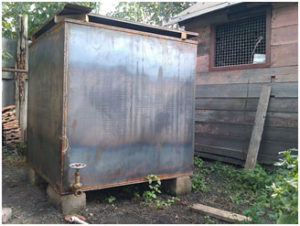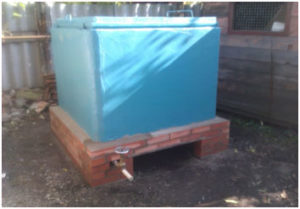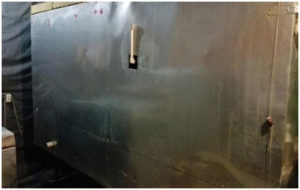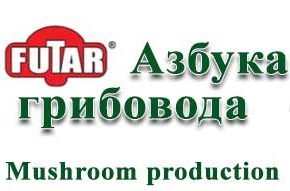Hydrothermal treatment
Hydrothermal treatment
Hydrothermal treatment is the most affordable way of treating mushroom substrates for households and small enterprises specializing in growing oyster mushrooms.
Substrate treatment (or “steaming”) takes place in an iron tank or a barrel with a water drain below.


An iron grid on legs is placed on the tank bottom. For better water circulation and more uniform heating, it is desirable to place such grids on the sides, at the walls of the tank, 2-3 cm from the wall. The walls of the tank must be thermally insulated (5 cm of polystyrene), this is important for the proper processing of raw materials (straw, sunflower husks, buckwheat or a mixture of all above).

The tank should have a thermally insulated lid (5 cm of polystyrene), which can be tightly closed.
It is necessary to have at least three temperature sensors to control the temperature in the substrate being treated.
One of them must be inserted into the center of the bag filled with plant raw materials in the bottom row, so that the sensor reaches the middle of the bag, another one – also in the center of the bag, but on the top row.
The third sensor can be put between bags or in water near the second bottom so that the sensor does not touch metal parts.
The water is heated from the bottom of the tank using heater coils (located between the bottom of the tank and the grid), a gas burner or firewood.
Step 1
For the convenience of work, dry raw materials are filled in polypropylene bags premixed with additives: chalk, gypsum or lime (see below).
If there is a polyethylene layer in the bag, it must be removed. Then put the bags in the tank.
The raw material for hydrothermal treatment can be straw and/or sunflower husk. Husk is the most acceptable option, because it is microbiologically more pure than straw and the probability of spoilage is lower. Also read our materials – “How to choose raw materials depending on the heat treatment method”
Soaking.
Water is poured into the container. If this process is slow and the flow can not be increased, then it is necessary to have an additional water source and fill the tank from these two sources. Raw materials should be completely covered with water at least 10 cm of water above the bags (you can press the bags on top with an iron mesh) and soak for at least 5-7 hours before the start of heating. It is desirable that the water temperature in the tank is 25-30ºC, in this range the spores of molds and bacteria change from dormant to active life form.
In order to avoid spoilage in the substrate, it is necessary to kill the foreign microflora present on raw material. These microorganisms are mainly in the state of spores, which die at a temperature of more than 120ºC. Therefore, the main task in preparing the substrate consists in the transition of the spores into active life forms – then they die at a temperature of 65-70ºC.
Heat treatment.
Water should be heated to the proper temperature rather quickly in about 3-4 hours. The substrate is heated the slowest from the top. Heating process should be stopped when the sensor in the top bag shows a temperature of at least 66 degrees. After that it is necessary to ensure that the time count starts after reaching the optimal temperature at all 3 sensors. The timing should be three hours for husks and 7-8 hours for straw. The temperature on all sensors should neither fall below 66 degrees, nor rise above 80ºC. Therefore, if you are heating using firewood, you may have to rake out the heat or to experimentally determine when to stop adding wood so that there is no overheating.
Substrate draining and cooling.
After heat treatment, the water must be drained. Since the tank is thermally insulated, the temperature in the bags will decrease slowly. Therefore, you can open (or slightly open) the tank cover. The optimal temperature for the development of competitive microorganisms is 30-40 C, so this temperature range must be passed as quickly as possible. This is achieved by transferring the bags to the room where the inoculation will take place. It is possible to inoculate the mushroom blocks (to add mycelium), when the substrate cools to 26-24ºC. The temperature of the mycelium should be approximately the same.
If, with such a technique, the substrate moisture remains below 65%, water can be drained gradually . Material can be left in water for 3 to 12 hours after heat treatment. Timing is determined experimentally, the main factor here is substrate humidity.
DETERMINATION OF SUBSTRATE MOISTURE
The optimal substrates humidity is different for different raw materials. It is 65-67% for sunflower husk, and 72-75% for straw substrates.
During hydrothermal treatment of the substrate, waterlogging is often observed. Therefore, it is necessary to control humidity by measuring it in each batch. The longer the processed raw material waits for inoculation, the the higher the infection risk of mold or bacteria.
Use of lime, soda and other additives in hydrothermal treatment.
When there are problems with oyster mushroom blocks development associated with the appearance of green (less often – black) mold, it is necessary to check pH level of the substrate. It should be within 7.8-8.2. This alkalinity level inhibits the development of molds. If you have a pH value within these limits, but the mold still develops in the mushroom block, you need to pay attention to substrate treatment process or change substrate manufacturer. Most likely, the temperature or timing treatment (or both) are violated. If the pH is lower, lime or technical soda should be added. The amount can only be determined experienced. Your task is to bring the pH to the desired level (7.8-8.2).
Chalk or calcium carbonate forms a buffer carbonate system in a moist substrate maintaining the pH of the substrate. Chalk slightly alkalizes the medium. It can be added at the stage of packing husks into the bags or after steaming (heat treatment) of the substrate – 4% of the dry substrate weight. In the latter case, it is desirable to calcinate it by heat. Gypsum or alabaster is used to improve the structure of the substrate by binding more free water.
Step 2. Inoculation with mycelium.
Read the continuation of the article here.
